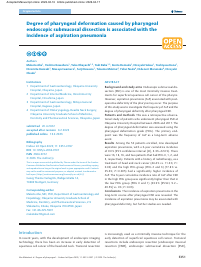Degree of pharyngeal deformation caused by pharyngeal endoscopic submucosal dissection is associated with the incidence of aspiration pneumonia
Permalink : https://ousar.lib.okayama-u.ac.jp/67945
| FullText URL | |
| Author |
Abe, Makoto
Department of Gastroenterology, Okayama University Hospital
Obayashi, Yuka
Department of Gastroenterology, Okayama University Hospital
Baba, Yuki
Department of Gastroenterology, Okayama University Hospital
Hamada, Kenta
Department of Gastroenterology, Okayama University Hospital
Sakae, Hiroyuki
Department of Gastroenterology, Okayama University Hospital
Kono, Yoshiyasu
Department of Gastroenterology, Okayama University Hospital
Kanzaki, Hiromitu
Department of Gastroenterology, Okayama University Hospital
Iwamuro, Masaya
Department of Gastroenterology, Okayama University Hospital
ORCID
Kaken ID
publons
researchmap
Kawano, Seiji
Department of Gastroenterology, Okayama University Hospital
ORCID
Makino, Takuma
Department of Otolaryngology-Head & Neck Surgery, Okayama University Graduate School of Medicine, Dentistry and Pharmaceutical Sciences
ORCID
Kaken ID
researchmap
Noda, Yohei
Department of Otolaryngology-Head & Neck Surgery, Okayama University Graduate School of Medicine, Dentistry and Pharmaceutical Sciences
Marunaka, Hidenori
Department of Otolaryngology-Head & Neck Surgery, Okayama University Graduate School of Medicine, Dentistry and Pharmaceutical Sciences
Okada, Hiroyuki
Department of Gastroenterology, Okayama University Hospital
Kaken ID
publons
researchmap
|
| Abstract | Background and study aims Endoscopic submucosal dissection (ESD) is one of the most minimally invasive treatments for superficial squamous cell cancer of the pharynx. However, aspiration pneumonia (AsP) associated with postoperative deformity of the pharynx may occur. The purpose of this study was to investigate the frequency of AsP and the degree of pharyngeal deformity after pharyngeal ESD.
Patients and methods This was a retrospective observational study of patients who underwent pharyngeal ESD at Okayama University Hospital between 2006 and 2017. The degree of pharyngeal deformation was assessed using the pharyngeal deformation grade (PDG). The primary endpoint was the frequency of AsP as a long-term adverse event. Results Among the 52 patients enrolled, nine developed aspiration pneumonia, with a 3-year cumulative incidence of 9.0 % (95 % confidence interval [CI], 3.3 %–22.0 %). There were 16, 18, 16, and two patients that had PDG 0, 1, 2, and 3, respectively. Patients with a history of radiotherapy, as a treatment of head and neck cancer (44.4 % vs. 11.6 %; P = 0.02) and the high PDG group (PDG 2 and 3) (77.8 % vs. 25.6 %; P = 0.005) had a significantly higher incidence of AsP. The 3-year cumulative incidence rate of AsP after ESD in the high PDG group was significantly higher than that in the low PDG group (PDG 0 and 1) (23.9 % [95 %CI, 9.2.–49.5%] vs. 0 %; P = 0.03). Conclusions The incidence of aspiration pneumonia in the long-term course after pharyngeal ESD was revealed. The incidence of aspiration pneumonia may be associated with pharyngeal deformity, but further studies are needed. |
| Published Date | 2023-02-13
|
| Publication Title |
Endoscopy International Open
|
| Volume | volume11
|
| Issue | issue04
|
| Publisher | Georg Thieme Verlag KG
|
| Start Page | E351
|
| End Page | E357
|
| ISSN | 2364-3722
|
| Content Type |
Journal Article
|
| language |
English
|
| OAI-PMH Set |
岡山大学
|
| Copyright Holders | © 2023. The Author(s).
|
| File Version | publisher
|
| PubMed ID | |
| DOI | |
| Web of Science KeyUT | |
| Related Url | isVersionOf https://doi.org/10.1055/a-2033-9707
|
| License | https://creativecommons.org/licenses/by-nc-nd/4.0/
|
